Welcome to my first entry in my new series, Winter is Coming, which I’ll be sharing over much of 2024.
Future entries in this series will be available to paid supporters of my writing, while the majority of my other posts will continue to be published for all subscribers. If you’d like to read along and support my creative work, you can do that right here:
Before enlightenment; chop wood, carry water. After enlightenment; chop wood, carry water.
— Zen Kōan
It became a predictable pattern: carry the frozen hoses into the shower, and run the hot water long enough for the ice to melt out and the hoses to run clear again. Try to do so without getting yourself soaked, or sweating through your winter gear in the steamy indoor bathroom.
Then, the race against the cold: can you re-attach the hoses from the well to the water filter, and the filter into the Airstream (conveniently, on the far side of the trailer from the well spigot), before anything freezes again?
Usually, the answer was yes.
When we told our friends and family we were buying an Airstream and would be living in it through our first Montana winter, we were met with some combination of shock, dismay, and confusion.
Why would you want to do that?
Is that even something you CAN do in that climate?
Will you be warm enough?
To be fair, we weren’t sure how it would go either—but we knew we were pretty excited to try. (As to the question of why, that’s one I’ll be diving into over the coming weeks and months of this series.)
It turns out, when you buy a travel trailer and move into it full-time, having never actually lived in a travel trailer before, you have a fairly quick learning curve around the everyday comforts you’ve always taken for granted.
Water was just the first thing that would open our eyes and begin to change our perspectives.




Once we purchased the Airstream — which we dubbed Winterfell, of course — we were fortunate enough to have a close friend who offered us a parking spot over the winter months on their property. We’d have access to a well and a septic, as well as an indoor bathroom & shower, in exchange for paying to install an RV circuit & doing some general winter caretaking of the property.
In some cases, you’d be able to permanently attach the water to the trailer, and have an endless supply just as you would in a home. But with the risks of the cold temperatures and deep snow we knew were in store for us, we’d have needed to bury and insulate the water lines to do this. For a short-term situation, that wasn’t worth the effort. Instead, we decided, we’d fill the Airstream’s fresh-water tanks — all 39 gallons worth — whenever we needed to.
How much is enough?
How much water is 39 gallons, you ask?
According to emergency preparedness guides, it’s wise to have water on hand for situations like power outages, winter storms, etc. The standard recommendation is one gallon per person, per day. So, according to this logic, we’d have enough water for the two of us for nearly 20 days.
But that’s based on emergency use. This recommendation doesn’t include comfortable use for pleasurable cooking, more than cursory cleaning, or showering for enjoyment, not just cleanliness. It’s the bare minimum. I don’t have good notes of how frequently we refilled our water tanks while living in this location, but my guess would be about every 12-14 days.
Even though we had “standard” plumbing in the Airstream: once the tanks were full, we could use the sinks & bathroom just like any other house (the exception being the loud water pump—more on that later). Yet, the simple need to check the water level, keep an eye on consumption, and fill manually every few weeks made us much more aware of our water usage.
This was the first, but not the last, time I’d draw a parallel between our goal of a sustainable lifestyle, and our travels in other parts of the world: managing water reminded me of our time in Pakistan, where we only used the filtered water from our giant countertop distiller, or my time working with a microfinance organization in India, where I saw rural women hauling water from the community well. I’d never wish to compare our voluntary lifestyle choices with the harsh realities of many who have no other alternative; rather, a consistent exposure to the many ways of creating a life on this planet has inspired me to seek alternatives and simplicity, rather than abundance and consumption, whenever possible.


When Water Freezes
The other way we danced with the element of water was, of course, with the snow and all of the beauty and struggle it provided.
Neither of us were strangers to snow. Between the two of us, we spent formative years in Colorado, Boston, and Moscow: all places known to be cold and winter-white. So, we had (some of) the gear, and (some of) the knowledge to be prepared for what turned out to be an epic Montana winter. Beau quickly became an adept level one snowblower-driver (if only we’d know what was to come…), while I leaned into my strongest winter skills of creating cozy spaces and baking/making hearty food. (Sometimes we just fill traditional gender roles, and that’s okay with us.)







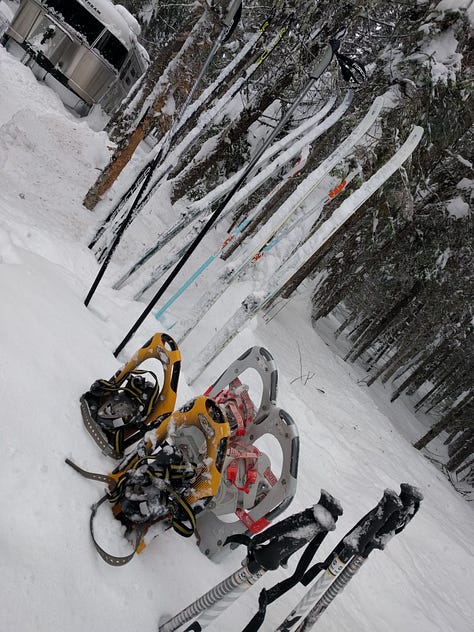
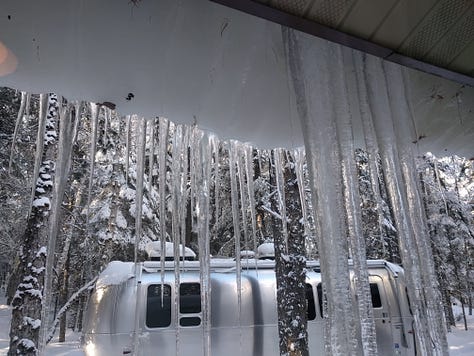
One of the biggest gifts of living tiny through a Montana winter is the ease of stepping outside. When you’re in such a small space, there’s more incentive than ever to embrace the weather and the elements and get outside to play. With our location only a short drive from incredible nordic ski trails as well as the chance to snowshoe right out our door, we had a lot of fun.

Keeping the Airstream warm and cozy wasn’t actually that challenging. We’d taken precautions advised by the internet: placing insulation panels around the opening beneath the trailer, and since we had the benefit of unlimited power at this site, running some extension cords to work lights, effectively heat lamps, beneath the water tanks. We made it through the winter without any issues with freezing pipes or infrastructure, and while the floor wasn’t always warm, it wasn’t uncomfortable, either. A well placed space heater or two took the edge off of any remaining pockets of cold.
Water, Black & Grey
One of the uncomfortable truths of living in a travel trailer is that you get much more familiar with your wastewater.
Most of us don’t ever give much thought to where our water goes after we use it (in the kitchen, in the shower, in the toilet). Until one of these systems breaks, we live in happy (and typically hygienic) ignorance of modern convenience.
While we had access to a septic with a dump area (thanks once more to the generosity of our friends), we had neither an insulated all-weather dump capacity, nor a permanent connection. So every so often — once the wastewater tanks were full — we got to manage this type of water.
I use the word “we” here, but this was 100% a task that I handed over (gratefully) to Beau. As with every project placed before his engineering brain, he invested in some upgraded hoses and connections that made this process slightly more streamlined. The act of intentionally adding water to the fresh tanks and actively flushing water from the waste tanks reinforced our observations on just how much water is needed to live comfortably, and piqued our curiosity even further to consider alternative ways of putting water to use: from greywater systems to rainwater harvesting, many of our future ideas and plans had their source here, in the humble practice of managing water for our Airstream.
Creative Solutions & Incremental Steps Forward
One challenge of our Airstream winter was a lack of storage space for our boots, coats, and wet winter gear. Ultimately, since we had the privilege of access to our friend’s indoor bathroom, we turned our Airstream shower into a wet gear closet, which worked like a charm. This experience only underscored our interest in having a proper mudroom/arctic entry in our future home—a lesson we’d implement to full effect by the end of our time in Montana.
Since we’d purchased our Airstream lightly used from another couple, there wasn’t too much we needed to do to it. This wasn’t the “total Airstream renovation/fixer-upper” you often see on Instagram. If full-time RV life had been our goal, that might have been on our agenda. But since we saw Winterfell as a means to an end, a more financially responsible tiny home to bridge the gap between where we were and where we hoped to be (even though we didn’t yet know quite what that was…), we didn’t devote too much time or energy to improvements. One thing, though, that we couldn’t let stand: the water pump. It was noisy, it made the lights flicker every time we used it, and it kicked on all the time. My favorite engineer (that’s Beau) had had it.
And thus we discovered one of the hidden joys of Airstream ownership: the absolutely nonsensical arrangement of systems.
Case in point: in order to remove the old pump, you had to reach around behind and unscrew the connection. Yet, the angle was such that the person holding the screwdriver literally could not simultaneously reach the screwdriver into the gap AND angle their head to see where it needed to go. And, to Beau’s utter disdain, the water pump was located behind and adjacent to the power distribution panel. Clearly, an engineer did not design this setup.
Thus, one of our first ventures into the world of “opportunities for marital success”1 , as one of us was the eyes while the other was the hands for this otherwise simple job.

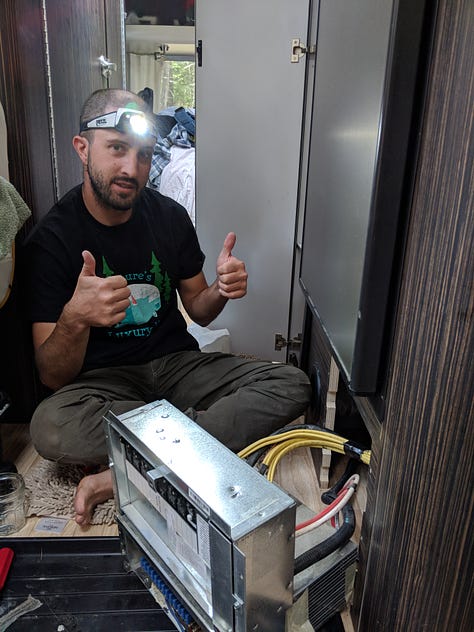

Of course, this was only the most minor of home improvement projects: had we any idea of what lay ahead of us, perhaps we’d have laughed a bit more at ourselves along the way. Either way, it was a huge upgrade to our water system and one that we enjoyed for some time to come.
Water and the Future
Access to water is one of the big questions of our time, and it’s one I follow with great interest and attention.2 During this first phase of our time in Montana — what we’d come to call The Montana Experiment — living firsthand with some of the realities that come when we turn off the easy button of the city water system, I became even more convicted about how we encounter and interact with water in our lives. In future chapters, I’ll take a closer look at water, the way we constructed our water systems, and our relationship with this precious global resource.
This is what we call those maddening experiences, often related to home improvement projects, navigating traffic in new cities, or dealing with other urgent (but not usually life threatening) situations, which make beloved spouses temporarily forget all of the reasons why they like each other and why the project in question seemed like a good idea at the time.
A few resources I’ve found especially helpful: Heather Hansman’s book Downriver: Into the Future of Water in the West, David Gessner’s A Traveler's Guide to the End of the World: Tales of Fire, Wind, and Water, and several episodes of the Mountain & Prairie Podcast, especially the conversation with Diana Lane & Aaron Derwingson on Thriving Rivers, Resilient Agriculture, and Strong Communities




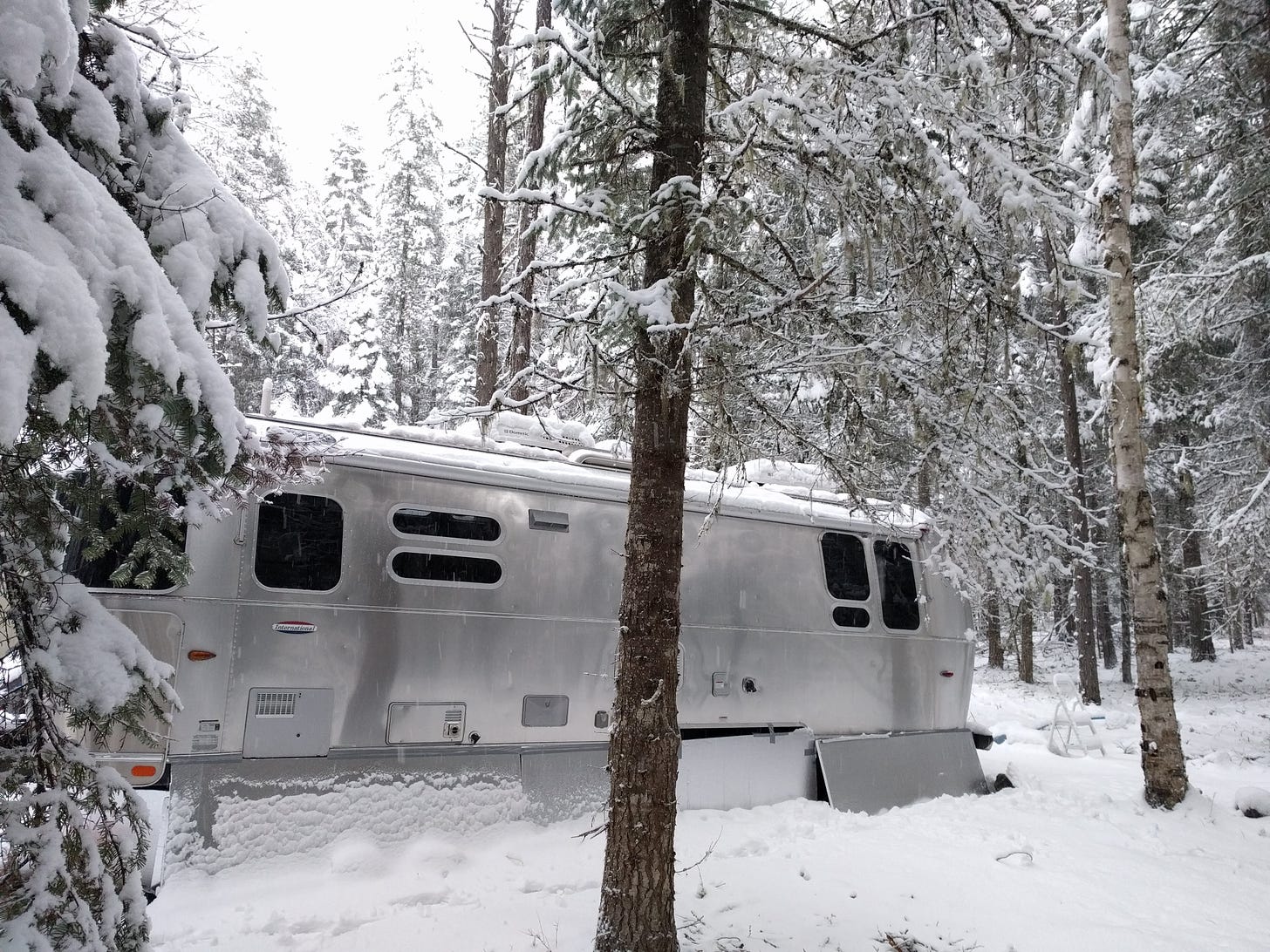
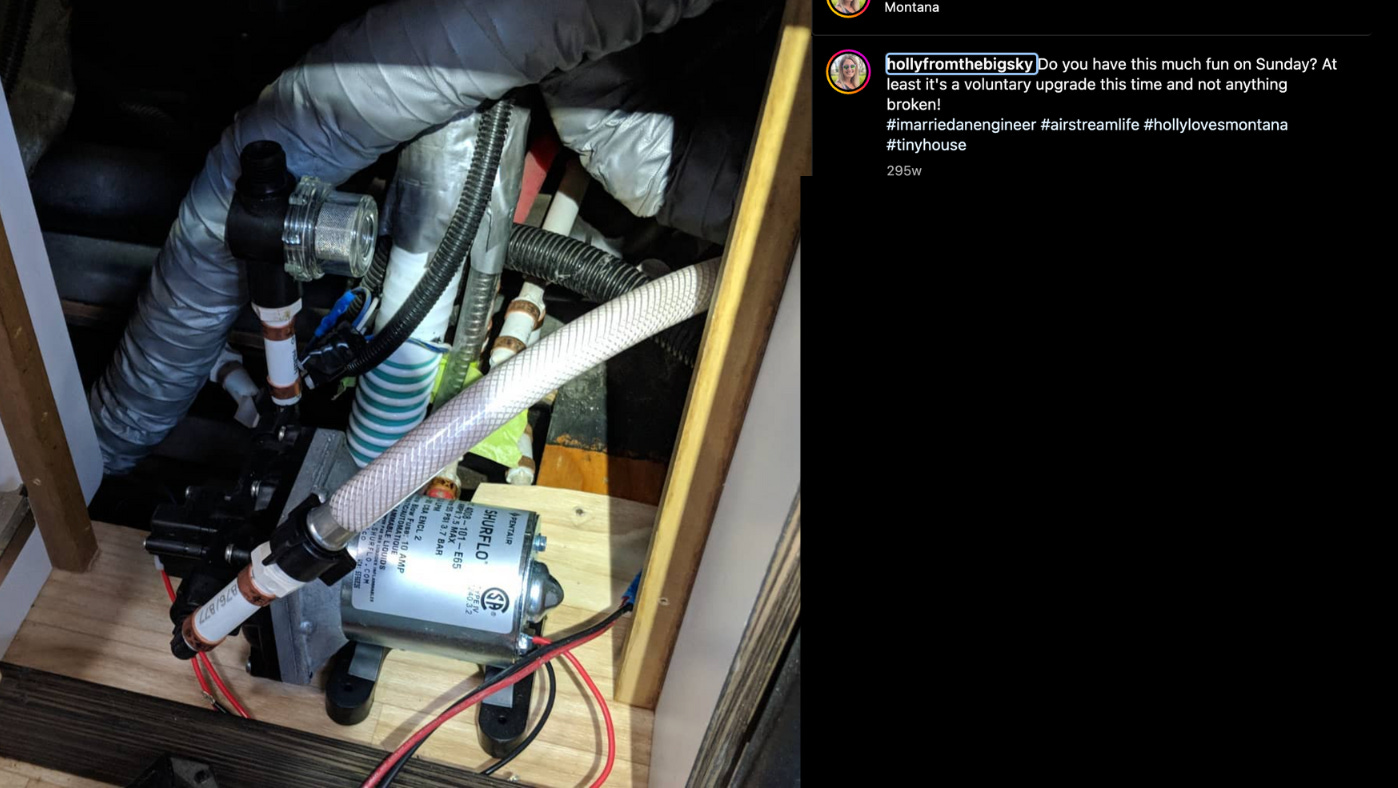
My first two winters in my sprinter were spent at 8000 feet in the Colorado mountains, so I know some of these experiences well… Though I’ve actually been strangely grateful I didn’t install plumbing. (Probably not strange to you 😅) But to this day I still love how much closer small/mobile living keeps me to nature, to the outdoors… I usually feel stifled in normal houses anymore.
I almost upgraded/expanded to an airstream at one point (actually bought one for one hot month, lol, but turned it around at a slight profit when I realized I was in over my head. Truth is: I never wanted to own a truck 😂 ) So I’ll stick with my sprinter until I have a spot to put a tiny home or something…
After a few winters further south, I’m back in the Colorado mountains, but this time at only 6500 feet. It’s practically balmy in comparison. (Ok, I shouldn’t joke, winter has just begun…)
It was amazing to read about all the essentials you and Beau enjoyed doing on a daily basis to take care of your beautiful Airstream. I will always remember how impressive and luxurious the interior was during the time I spent 3 days with you to celebrate my birthday in Glacier National Park. There was no snow at that time. Reading about all you had to do to keep the Airstream a comfortable place to live...The two of you are so adventurous! Made me pause and wonder how the pioneers crossed the west in the mid 1800's in covered wagons...Hats off to both of you for your skills and enthusiasm to build such a life during that period of your lives together!